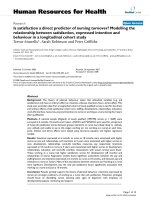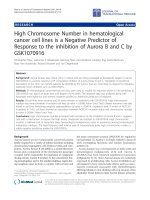Perspective phép vẽ phối cảnh
Bạn đang xem bản rút gọn của tài liệu. Xem và tải ngay bản đầy đủ của tài liệu tại đây (769.01 KB, 40 trang )
Lecture 5 Thursday 27 November 2014 1
ENGINEERING GRAPHICS
1E9
Lecture 5: Perspective
Lecture 5 Thursday 27 November 2014 2
Perspective/Central projection
•
Perspective is a geometric method of representing on
paper the way that objects appear in real life i.e. they
get smaller and closer together the further away they
are from the eye of an observer.
•
It is the most realistic of all pictorial drawings
•
It is is the way real three-dimensional objects are
pictured in a photograph that has a two-dimensional
plane
•
Perspective or central projection is used in creative art
or technical sketching but seldom in technical drawing
Lecture 5 Thursday 27 November 2014 3
Projectors or line of sights are not parallel
to each other
Lecture 5 Thursday 27 November 2014 4
Pictorial drawings
Perspective drawings differ from other types of
pictorial drawings.
In Isometric, Dimetric, and Trimetric drawings,
the lines remain parallel and never converge at a
single point.
They are useful for conveying technical
information but lack the quality of realism when
compared to the perspective view.
Lecture 5 Thursday 27 November 2014 5
Perspective System
MAIN ELEMENTS
1. The observer’s eye
2. The object
3. The plane of projection
4. Line of sight
Lecture 5 Thursday 27 November 2014 6
Perspective System
•
Observer’s eye is station point SP and the visual
rays are the line of sights
•
Picture plane is the plane of projection or the
paper
•
Visual ray at eye level marks horizon on picture
plane
Lecture 5 Thursday 27 November 2014 7
Perspective System
Lecture 5 Thursday 27 November 2014 8
Vanishing Point
•
The lines parallel to each other but
not parallel to the picture plane
converge towards a single point on
the horizon - VANISHING POINT
Lecture 5 Thursday 27 November 2014 9
Notes
•
Observer’s eye is station point SP
•
Visual ray at eye level marks horizon on picture plane. The
horizon line (HL) is the position of horizon.
•
The central line of sight should direct towards the centre of
interest.
•
The location of the picture plane (PP) determines the size of
the object on the PP. Moving the PP alters perspective or
scale but not proportion.
•
The lines parallel to each other but not parallel to the PP
(horizontal lines) converge towards a single point on the
horizon - Vanishing points (VP)
•
The ground line (GL) represents the edge of ground plane on
which object rests. GL defines the lower limit of drawing.
Lecture 5 Thursday 27 November 2014 10
Perspectives
Lecture 5 Thursday 27 November 2014 11
Types of Perspective
•
1-point perspective/Parallel
perspective
•
2-point perspective/Angular
perspective
•
3-point perspective
Lecture 5 Thursday 27 November 2014 12
One-point Perspective
Lecture 5 Thursday 27 November 2014 13
One-point Perspective
•
One face of object is parallel to
picture plane, one VP
Lecture 5 Thursday 27 November 2014 14
Two-point Perspective
Lecture 5 Thursday 27 November 2014 15
Two-point Perspective
•
Object at angle with picture plane,
but vertical edges are parallel to
picture plane, two VP
Lecture 5 Thursday 27 November 2014 16
Three-point Perspective
Lecture 5 Thursday 27 November 2014 17
Three-point Perspective
•
No system of parallel edges with
picture plane, three VP
Lecture 5 Thursday 27 November 2014 18
1-point perspective drawing (1)
A simple one-point
perspective of a cube is to be
constructed from a plan view
Step 1 Establish an arbitrary horizon
line (HL) depending on the
eye level you wish to portray
Step 2 Locate the picture plane (PP)
so that it does not interfere with the
drawing. (The PP may be same as HL)
Lecture 5 Thursday 27 November 2014 19
1-point perspective drawing(2)
Step 3 Draw the plan view above or
below the PP (easier to draw it resting
on top of PP)
Lecture 5 Thursday 27 November 2014 20
1-point perspective drawing(3)
Step 4 Draw the ground line (GL) in an
arbitrary location below and parallel to
the PP
Lecture 5 Thursday 27 November 2014 21
1-point perspective drawing(4)
Step 5 Locate the station
point (SP) not less than
twice the width of the
object and directly in
front of or to one side of
the plan view.
(SP may also be placed 2 or 3 times
the object’s greatest length from
the nearest point of the plan view
but if placed any closer, distortion
of the perspective will result.)
Lecture 5 Thursday 27 November 2014 22
1-point perspective drawing(5)
Step 6 Project the width of the plan view to
the GL.
Step 7 Draw the elevation of the object on
GL. If the plan view of the object is touching
the PP, the elevation is true in size. If the
plan view is behind or in front of PP, the
elevation is smaller or larger, respectively
Step 8 Project a vertical line from the SP to
the HL to locate the VP
Lecture 5 Thursday 27 November 2014 23
1-point perspective drawing(6)
Step 9 From the corners of the front
view (D, E, G and F), draw visual rays to
VP
Lecture 5 Thursday 27 November 2014 24
1-point perspective drawing(7)
Step 10 The line from point A of the
plan view to SP intersects the PP at point
H. Draw a perpendicular line from H to
intersect the visual rays (points J and K).
Lecture 5 Thursday 27 November 2014 25
Perspective of a wooden floor









